Text and maps copyright Howard Wiseman 2003-2018.
Last Modified: 15th November 2018
There has been a British Empire for most of the time from the first century A.D. By this I mean that Britain (*) has been dominated by an Empire (**) having its territories in Britain as its primary (***) or sole element. That is not to say that this Empire has always been the same. Rather, that role has been held by, amongst others, a Romano-British Empire, a British confederation, Northumbrian, Mercian, and West Saxon kingdoms, and, since the 10th century, the kingdom of England. Neither is that to say that the Empire's territories in Britain have always been the largest or most populous element of this Empire. For example, in 1172 the territories of the Plantagenet Empire in France were collectively larger and more populous than England, but only England had the status of a Kingdom.
The maps below illustrate the changing British Empires from A.D. 40 to 1945. I use different colours to give an idea of the ethnicity of the ruling class at different times. Stippling indicates areas effectively controlled, but not directly ruled, by the Empire. The dates of the maps (one per century except in the Roman period) have been chosen carefully to illustrate these Empires at interesting times, usually territorial maxima. It is interesting to see that, except for 973, the Empire either did not control the whole of Britain, or had elements in Europe outside the British Isles, or frequently both. The whole of Britain was controlled by one ruler for the first time around 973, but was not securely so controlled until 1745. And for almost all of the time from 1016 to 1453, and 1689 to 1820, the dominant or sole monarch in Britain was also monarch of significant territories in continental Europe. The unity and insularity of Britain is thus a comparatively recent phenomenon, and appears now to be waning.
* by "Britain" I here mean Great Britain: modern England, Scotland and Wales. The "British Isles" also includes Ireland and the Isle of Man.
** by "Empire" I here mean a state having overseas elements, or a heartland controlling a periphery.
*** by "primary element" I mean that these territories have, arguably, the highest status within the Empire. The Roman Empire is thus excluded from consideration, as Britain was merely a group of minor provinces in that vast Empire.
Return to Howard Wiseman's History page
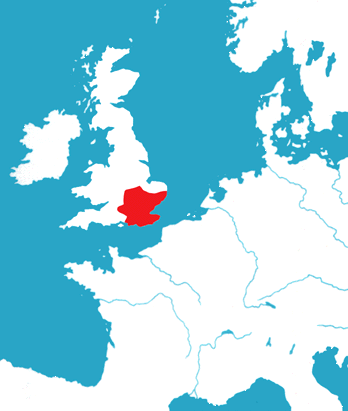
Cunobelinus, king of the Catuvellauni, was the greatest of the
Celtic kings in Britain prior to the Roman conquest. The tribal lands of the
Catuvellauni were in the southern midlands, but his kingdom, shown here at the
approximate time of his death, covered all of south-east Britain. The Romans
historians even referred to him as the king of the Britons, rex Britannorum,
a title which did not certainly re-appear for more than
400 years. He minted coins and traded extensively with the
continent. Annexation of other kingdoms continued under his sons, Caratacus and
Togodumnus. This included the Atrebates, a kingdom which had become a Roman client
state at the time of Julius Caesar's expedition to Britain in 55 BC.
This gave the Roman Emperor Claudius an excuse to invade, in 43.
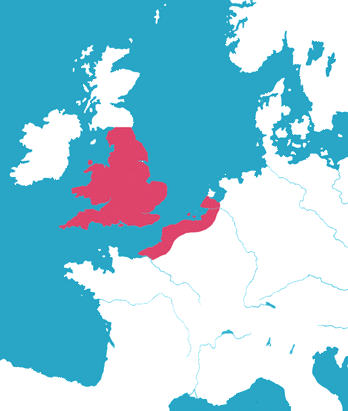
Togodumnus died in fighting near London in 43, and the whole of the
Catuvellauni Empire was occupied by the Romans. His brother Caratacus
continued the fight, rallying the Britons in what is now Wales until he was
captured in 51. This was not the end of resistance, however. In 61, Boadicca,
queen of the Iceni (in what is now Norfolk) lead a revolt in which tens of
thousands of Romans were killed. She was soon defeated however, and all of
Britain south of the Solway Firth was occupied by 74. The campaign was
continued against the Picts far into the highlands of what is now Scotland.
However, by 122 the Emperor Hadrian had pulled the frontier back, and ordered
the construction of his famous wall, east from the Solway Firth. Britain
became a peaceful backwater in the Roman Empire, and its free men became Roman
citizens in 212. The third century invasions by Germanic tribes across
the Rhine and Danube upset the peace, and for a while (260-74) Britain
was part of a break-away Gallic Empire. Then in 286 or 287, Carausius,
commander of the channel fleet, declared himself Emperor in Britain. He
did this largely to avoid being arrested for alleged negligence in his
defence of Britain against Saxon raiders. The troops in Britain
supported him, as did some on the opposite coast of Gaul. He thus became the
first independent ruler of what is now England and Wales.
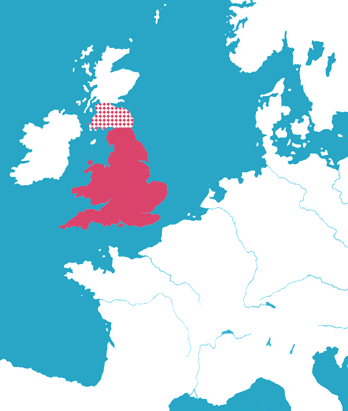
Carausius' Imperium was grudgingly recognized by the two legitimate
Roman Emperors in 290, and he dreamed of being their equal. Britain
prospered under his rule, but in 293 he was murdered by his finance minister
Allectus. Lacking Carausius' popular support, he succumbed to a Roman
reoccupation in 296. Following Carausius, Britain was to throw up many more
usurpers. One, Constantine, conquered the whole Roman Empire (305-324),
established its new capital (Constantinople, in 330) which was to last more than a
millennium, and made Christianity the state religion. No-one more
justly earned the epithet, "the great". A second usurper, Magnus Maximus
(383-88) was ultimately unsuccessful, but was late enough and important enough
to be remembered in the oral history of Mediaeval Wales. There his
rebellion was transformed into a fairy story, the Dream of Maxen Gwledig (Prince
Maximus). By 406 the Roman Empire was in a sorry state, with Germanic
tribes again pouring over the Rhine and Danube. The troops in Britain revolted
again, electing and then rapidly deposing a soldier Marcus, and then
replacing him by a civilian Gratian. The map above shows his territory at this
time, assuming that all of Roman Britain was loyal to the usurper.
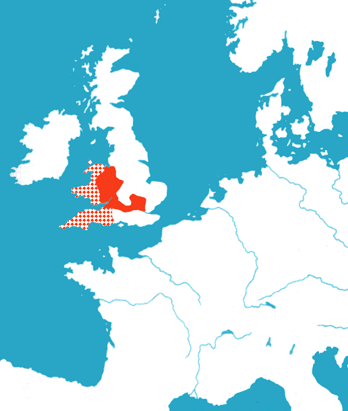
Gratian was in turn deposed, perhaps because of his inaction, and a soldier Constantine, raised to the throne. He took his troops to Gaul, and there met his end, in much the same manner as Magnus Maximus, in 411. By then the Roman Empire was too concerned with the Goths (who had invaded Italy) to care about reoccupying Britain. The British city-states were told to look to their own defences against the raiding Scots (from Ireland), Picts, and Saxons. Unlike the rest of the Western Roman Empire, they actually did defend themselves reasonably successfully, and evidently maintained some sort of central government. Renewed raiding by the Picts compelled the council of Britain, led by Vortigern, to settle Saxon mercenaries (presumably marines) in the east of the Island. This was probably in the 440s, though the details of this whole period are very uncertain. The Saxon settlements grew, and sometime later, perhaps around 460, they revolted. Many Britons fled overseas to Gaul, thereby founding Brittany. A King of the Britons, Riothamus, campaigned for the Empire in central Gaul in the late 460s. Others, led by Ambrosius Aurelianus, stayed behind and fought. Perhaps around 500, the Britons had a major victory, probably near Bath. Their leader, according to a Welsh scholar (Nennius) some 300 years later, was the warrior Arthur. Following this victory, relative peace was maintained between the Saxons kingdoms in the east and the British city states and kingdoms for several decades. The map above shows what remained of the British city-states (from archaeological evidence). One contemporary source (Gildas) hints that these were still parts of a confederation, and also that they exerted some authority over British kingdoms further west (but probably not those in the north).
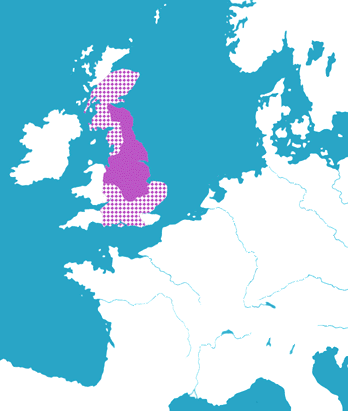
Although the British called (and, as the Welsh, still call) the
Germanic
invaders Saxons, they differentiated themselves, although not always
consistently,
into Angles, Saxons, and Jutes (whose name is forgotten in the general
term Anglo-Saxon). In the later 6th century they organized themselves
into
kingdoms large enough to defeat the Britons, whose unity had crumbled
anyway.
After the failure of a last great campaign under Cadwallon of Gwynedd
in 634, the Britons were made subject, or driven permanently into Wales,
Dumnonia
(the west country), and Cumbria. By then, three large Angle kingdoms
dominated the north and middle of England (Northumbria, East Anglia and Mercia),
three Saxon kingdoms the south (Wessex, Sussex, and Essex), with a
Jutish kingdom in Kent. The Anglo-Saxon kings vied with one another to hold
the Empire, as Bede called it in the 8th century, or to be Brytenwalda/Bretwalda
(Britain-ruler),
as the Anglo-Saxon chronicle called it in the 10th century. The title
meant a recognition, however nebulous, of that king's authority over his
fellow Anglo-Saxon kings. In the 7th century, the title was held most often by
the kings of Northumbria. The map above shows the Northumbrian Empire
at its height in 658 when Oswyu ruled directly over much of Mercia, and
was recognized as Bretwalda by all the Anglo-Saxon kingdoms except
Kent. His authority was even recognized in Cumbria and most of what is now
Scotland (inhabited by Britons in the south, Scots in the west and Picts in the
north). By this time the conversion of the Anglo-Saxons to
Christianity, begun in 597, was mostly complete.
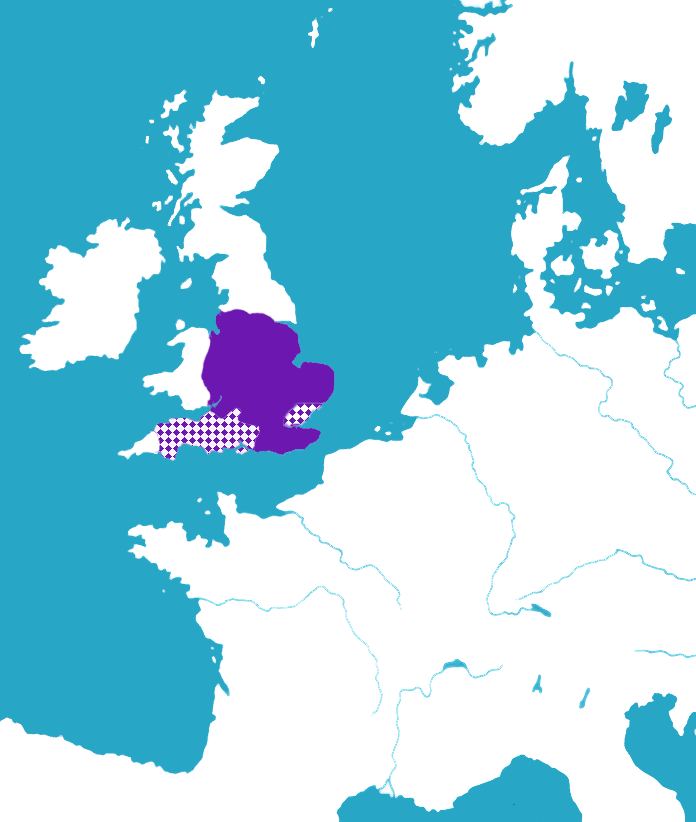
Mercia regained its independence from Northumbria in 658 and soon
became the dominant power south of the Humber. Northumbrian power was further
reduced by a disastrous campaign against the Picts in 685, where the
Northumbrian army was trapped and destroyed in a valley at Nechtansmere in the
Scottish highlands. Aethelbald (716-57) became the first Mercian Bretwalda,
receiving the homage of all the Anglo-Saxon kingdoms except Northumbria, and took
London away from Essex. His successor Offa (757-96) went even further,
annexing many of the smaller kingdoms: Sussex, Kent and East
Anglia (the last not until 794). He also pushed the kingdom of Wessex well
south of the Thames, and made it subject to him. He is most famous for Offa's
dyke, built as a boundary between his kingdom and the small kingdoms of
Wales. He called himself king of all the Angles, and treated with
Charlemagne on near equal terms.
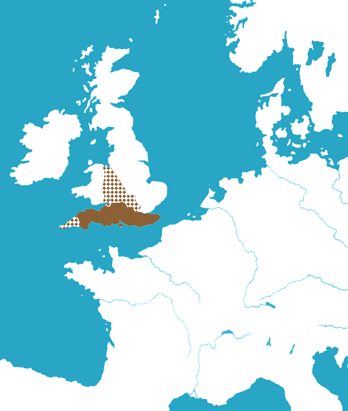
Mercia's dominance did not long survive Offa's death. In 825 the
East Angles rebelled, and the West Saxons under Egbert defeated the
Mercians. Following this, Essex, Sussex, and Kent detached themselves from
Mercia, and in 829 voluntarily became provinces of Wessex. After another
defeat, Mercia accepted Egbert as Bretwalda, as did East Anglia. Shortly
afterwards, Vikings, who had first raided Northumbria in the 790s, reappeared in
force. Egbert defeated them and their allies in Cornwall (all that remained of
Dumnonia), reducing the country to vassalage. Viking raids intensified
in the reign of his son Aethelwulf (839-58) and in 865 a Great Army of
Danes arrived in East Anglia, this time intent on staying. By 877 they
had conquered East Anglia, Essex, eastern Mercia (the Five Boroughs)
and southern Northumbria (York), and placed a puppet on the throne of
western Mercia.
Only one king remained independent, Alfred (871-99), youngest son of
Aethelwulf, and even he paid gold to the Danes to forestall their raids. As its
rule spread, the Great army divided, but it was still a formidable force
under Guthrum which invaded Wessex in January 878. Driven all the way to
Somerset, Alfred rallied and defeated the Danes. In 884 he recaptured London, and
signed a treaty with Guthrum, which demarcated the line between Danish
and Saxon territory. The latter consisted of Wessex and "English
Mercia", which became a vassal of Wessex. This is the situation shown
in the map above. Remarkably, Alfred is as famous for his scholarly
achievements as his military ones, and he is the only English king to have been
given the epithet "the Great".
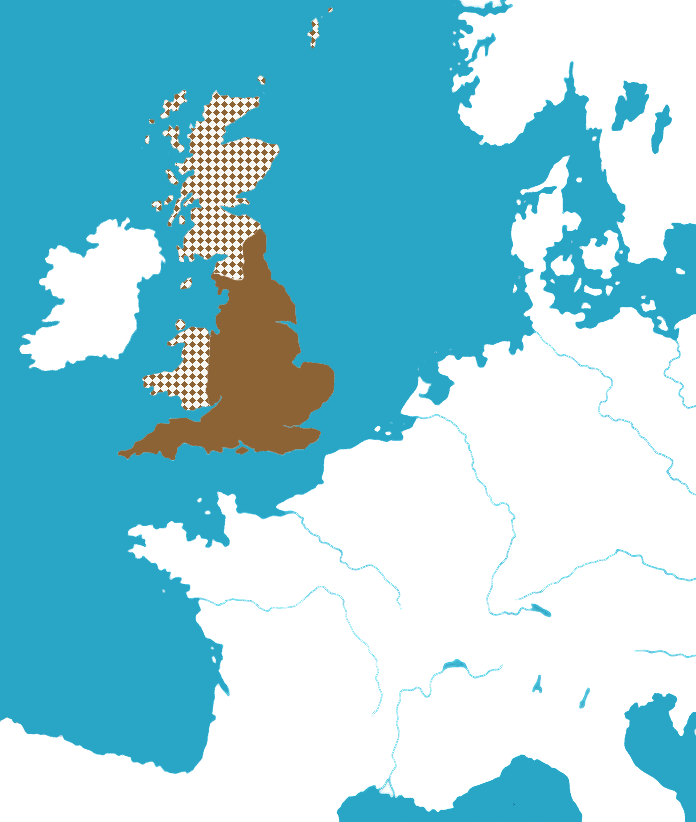
From 884 to 927 Alfred, then his son Edward and grandson Aethelstan
conquered all of the Anglo-Saxon areas that had been occupied by the
Vikings.
The other inhabitants of the Island fought against the creation of such
a powerful state, most notably in 936 when the Scots, Welsh from
Strathclyde
and Cumbria, and Vikings from Dublin combined to attack Aethelstan. In
a battle at Brunanbuhr (possibly near Chester), described by a
contemporary
as the greatest slaughter since the Angles and Saxons had won their
country
from the Britons, the English army was victorious. However Viking
armies
from Dublin reoccupied large parts of the north after Aethelstan's
death
in 939 and were not finally defeated until 954. Thus Eadwig in 955 was
the first king to begin his reign holding the whole of England
securely.
But even now the existence of a united England was no foregone
conclusion:
from 957 Eadwig held only Wessex (i.e. all the land south and West of
the
Thames) and Essex, the other regions having chosen his brother Edgar as
their King. On Eadwig's death in 959, England once again had a single
ruler,
and it was then, if at any time, that the Kingdom of England was
established.
In 973, Edgar was crowned in Chester, and received the submission of
the
other Kings of the Island, including Iago of Wales, Malcolm of Cumbria,
Dunmail (Malcolm's father) of Strathclyde, Kenneth of Scotland (who had
taken Edinburgh in 962) and Maccus, King of the Isles (from Man to the
Orkneys). This was the apogee of Anglo-Saxon England.
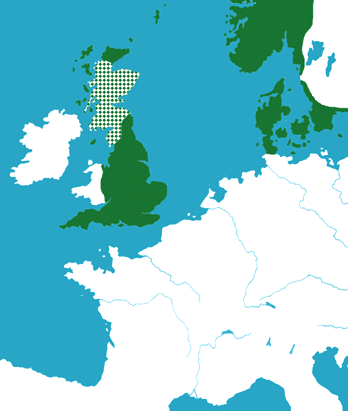
The Britain of which Edgar was King had been irrevocably changed by the Danish invasions, and indeed his laws refer to all people of his nation "be they Englishmen, Danes or Britons" (where "Britons" probably meant Cornish). Moreover, within 5 years of Edgar's death (974), the Scandinavians showed they were no spent force. In a near-repeat of events a century and a half before, Viking raids on England increased in ferocity and frequency, and the English were forced to pay Dane-gold once again. In 1002, the English King Aethelred the Unready (meaning the ill-advised), ordered a massacre of Danes, whom he suspected were planning to overthrow him. This must have created ill-will among the majority of the Danish population who survived, still dominating the north and east of the country. It is thus not surprising how quickly these areas submitted to the invading army of Sweyn, the first Christian King of Denmark, in 1013. His conquest incomplete, Sweyn died in 1014, and was succeeded by his son, while Aethelred did likewise in 1015. The two sons, Cnut and Edmund respectively, agreed to partition the country, with Edmund keeping only Wessex (the land south and west of the Thames). But Edmund died in 1016 and Cnut was recognized as King of all England. In 1019 he succeeded his brother to the throne of Denmark, and in 1027 added that of Norway. With the latter came the lordship of the Isles, from northern Scotland to the Isle of Man, and in 1031 Cnut forced the King of Scotland (which had subsumed Strathclyde and Cumbria in 1018) to submit. Only Wales, which had regained its independence from England, was outside Cnut's influence. The future of Britain, it would have seemed, was as part of a "greater Scandinavia".
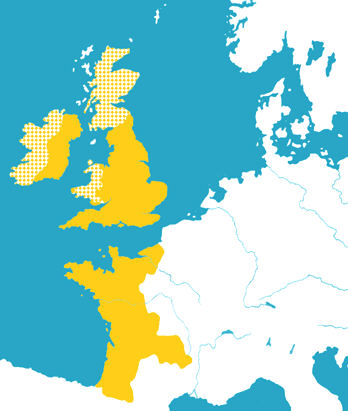
Cnut died in 1035 and his dynasty ended in 1042. England reverted to
the rule by the house of Wessex in the person of Edward "the
confessor",
last-born son of Aethelred the unready. But Edward, fleeing one nation
of Scandinavians, the Danes, had been brought up in the court of
another,
the Normans. These were descendants of Vikings who, following the
English
recovery under Alfred, had tried their luck in France, and had been
granted
territories in the north by the French king in 911. Their expanded
lands
became known as Normandy, and by the time of their duke William
(1035-1087)
theirs was the strongest French dukedom. Edward invited Normans to his
court, and to settle on the newly troublesome Welsh borders. When
Edward
died childless in 1066, William claimed, perhaps in truth but in any
case
with Papal backing, that Edward had named him as heir to the throne.
Meanwhile
Harald the king of Norway claimed the throne as a relative of Cnut.
Harald
invaded first and was beaten by Harold Godwinson, an English earl who
had
been elected King. A few days later William invaded. Harold hurried
south,
but this time was defeated and killed. It took William some 15 years to
completely subdue England, and in the process he almost completely
dispossessed
the English nobility. Parts of Wales were quickly overrun, and the
remainder
was usually submissive. In 1154 the Norman inheritance fell to Henry of
Anjou (a dukedom to the south of Normandy). Through his wife, he ruled
further vast areas of eastern and central France. In 1155 the only
English
pope in history granted Ireland to Henry, and by 1172 he had conquered
its eastern part, and obtained the submission of the rest, under Rory
O'Connor,
the last high-king of Ireland. In 1157 Henry defeated the Scots,
reconquering
areas they had occupied in the civil war that had preceded his reign,
and
forced them to submit. This huge Empire of Henry Plantagenet (called so
after his father's nick-name) was the richest in Western Europe.
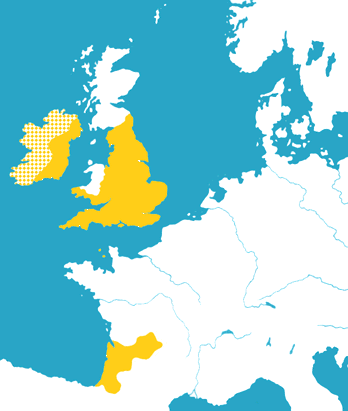
The first half century of Plantagenet rule (1154-1204) saw the kings
of England spend most of their time in France. Despite this, they
managed
to lose almost all of their French territories, mostly during the reign
of Henry's yougest son John (1199-1216). By the peace of Paris (1259)
John's
son Henry III recovered the Plantagenet position somewhat in the South.
But in the British Isles things were also not going well for the
Plantagenets.
Wales under the leadership of Gwynedd recovered its independence by
force
of arms. Llewellyn, as Prince of Wales, recognized Henry as his
overlord
in 1267, but at this time all of the Kings of England also formally
paid
homage to the King of France; in both cases it was merely a formal
submission.
Scotland likewise became independent again. Even in Ireland the area
under
direct Plantagenet control (the Lordship of Ireland, first held by John
from 1177) was shrinking if anything.
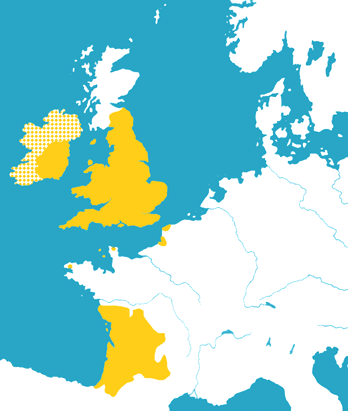
Henry III was succeeded in 1272 by his son, the warrior King Edward
I. He finally conquered Wales in 1282, and made it a principality to be
held by the heir to the English throne. Scotland became a dependency in
1290. It regained its independence under Robert the Bruce in 1328,
although
with a border adjusted in favour of England by Edward III in 1334. By
then
the Plantagenets were again preoccupied with France. In 1331, Edward
III,
grandson of Edward I, had declined to do homage to the King of France,
breaking the custom which had been established in 1066. He did so
because
not because he wanted England to be independent from France, but
because
he had decided (not without some justice) that his claim to the throne
of France was stronger than its incumbent, Phillip VI. He made this
claim
official in 1337, beginning the hundred years war (which actually
lasted
until 1453, with occasional truces). Edward overrun all of Aquitaine,
but
could not gain recognition of his claim to the French throne. In 1360
he
abandoned that claim in return for recognition of his conquests. By
this
time, the ruling class in England had begun speaking English rather
than
French, although the royal family remained bilingual. The black death,
which first struck Britain in 1349, did much to sweep away the old
order.
The war with France gave rise to anti-French feeling. This did not
extend
to the Aquitainians, who, despite having been conquered by the Franks
in 508, still maintained a separate identity, and looked the
Plantagenets
to maintain their political separation from France.
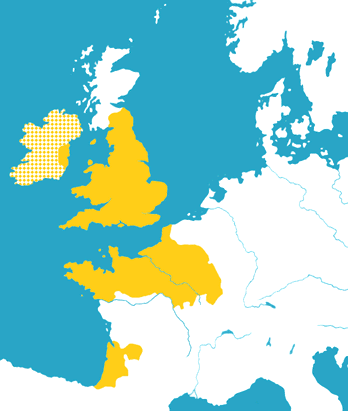
The war with France was resumed in 1369, under the Edward the Black
Prince (of Wales). By 1380 the Plantagenet holdings in France had been
reduced to only a few ports. Things were going no better in the Isles.
The Lordship of Ireland had been reduced to the area around Dublin,
"the
pale". Wales revolted and Owen Glyndwr was briefly (1404-6) master of
all
Wales, even negotiating with English nobles to divide the whole of the
realm between them. Henry IV, grandson of Edward III and the first king
of the Plantagenet house of Lancaster, managed to suppress all
opposition.
His son, Henry V, then decided the time was right to renew the war with
France. The French King Charles VI was mad and the Duke of Burgundy in
eastern France was a potential ally. He invaded in the North and won a
decisive victory at Agincourt, where an army of French knights,
slogging
through a muddy field, were slain by English and Welsh archers. The
French
lost their will to fight, and five years later Henry was recognized as
heir to France. Unexpectedly, he died a few months before Charles VI in
1422 so his infant son Henry VI became king of England and France. The
French clergy refused to accept Henry, recognizing instead the Dauphin,
son of Charles VI, as Charles VII. He still ruled most of France, but
the
English armies, with their Burgundian allies, continued to advance
slowly,
and in 1429 were besieging Orleans on the Loire.
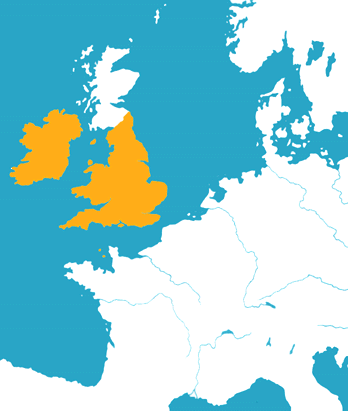
The siege of Orleans failed when the French were spurred to take the
initiative by Joan of Arc. Although she was captured and judiciously
murdered
in 1431, her achievements had shattered the English reputation for
invincibility.
By 1453 England had lost all its holdings in France (except for Calais,
which it kept for another century, and the Channel Isles, which still
remain).
By this time, the Kingdom of England was on the verge of civil
war,
between the junior Plantagenet houses of Lancaster (under the mad King
Henry VI) and York (under Richard, his regent, who had claimed the
throne).
The war was to last 30 years (1455-85), and allowed the Scots to regain
their pre-1334 frontier. The "wars of the Roses" -- both houses had
Roses
as their symbols -- would see the end of many noble families, creating
new opportunities for "native" English and Welsh families. Indeed, the
Lancastrian victor of 1485 was Henry Tudor, whose surname was derived
from
his Welsh grandfather. Many Welshmen even saw Henry VII's victory, at
the
head of a partly Welsh army, as fulfilling the prophecy that they
would
one day regain all of Britain. In 1536 his son Henry VIII removed the
political
institutions that had stigmatized Wales as a conquered country, but the
new united Kingdom was still generally known as England, and it was
English
law which prevailed. Henry VIII is most famous of course for founding
the
church of England in 1534. Its ambiguous status (anti-Papist, but not
really
Protestant) and imposition from above caused recurrent religious and
political
problems in the Kingdom for a century and a half. It also made it
necessary
for Ireland to be made a Kingdom in 1541, in personal union with the
Kingdom
of England, because the lordship of Ireland had been a Papal grant.
During
the reign of Henry VIII's daughter Elizabeth I (1558-1603), English
rule
over Ireland was made effective for the first time. In her reign, the
English
fleet enabled England to found its first trans-oceanic colonies (in
North
America) and prevented an invasion by Europe's greatest power by
defeating
the Spanish Armada of 1588.
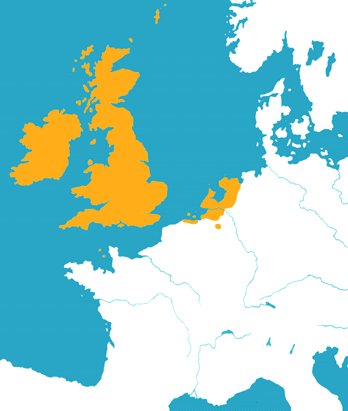
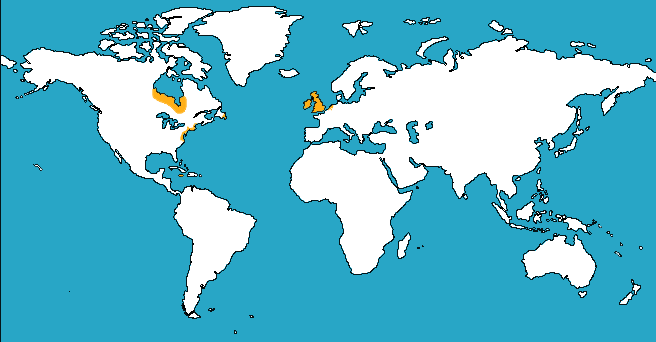
On the death of the childless Elizabeth in 1603 the kingdoms of
England
and Ireland fell into the lap of her nephew James Stuart, king of
Scotland.
In this way the British Isles came under one monarch for the first
time.
Although James considered himself king of Great Britain (and Ireland),
the
parliaments of England and Scotland considered otherwise and maintained
the distinction between the two countries. Shortly afterwards the first
really successful English colony in North America, was established. The
town was named after James, and the colony after his predecessor, the
Virgin
Queen. The rule of lord protector Oliver Cromwell between the execution
of James' son Charles (1649) and the restoration of Charles' son
Charles
II (1660) did little to interrupt the growth of the Empire. The
American
colonies continued to grow at the expense of the native Americans, and,
increasingly, at the expenses of other European powers (Jamaica taken
from
the Spanish in 1655, New York from the Dutch in 1664). Meanwhile the
Catholic
Irish were treated little better than the native Americans, with almost
all of the land reserved for protestant landlords from Britain. In 1688
Charles' brother James II, the last Stuart king to reign in Britain,
was
overthrown because of his Catholicism and the birth of an heir to a
Catholic
wife. In a prime example of the "Whig interpretation of history", this
has become known as the "glorious revolution". James' daughter by a
previous
marriage, Mary, and her solidly Protestant husband, Prince William of
Orange
(the Netherlands), were invited to become joint monarchs. An invading
Dutch
army convinced James and his Tory supporters that their cause was lost.
By this nearly bloodless coup the position of the parliament of
England,
as the source of the legitimacy of the monarch, was established.
Henceforth
the monarchs of Britain reigned, but did not rule.
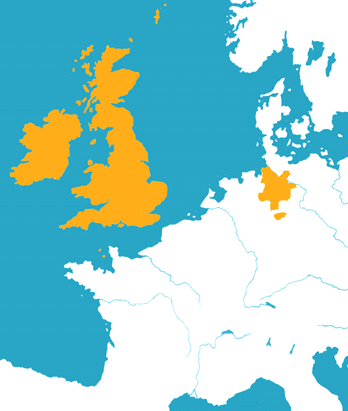
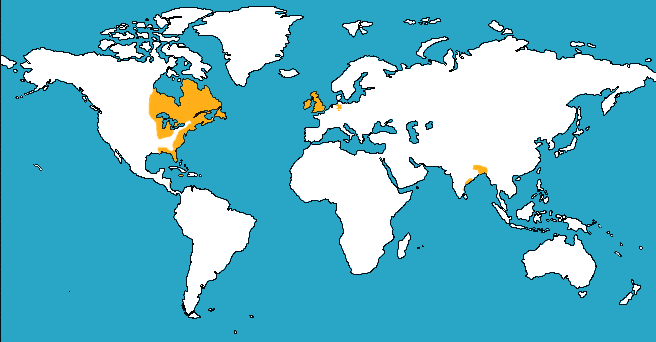
Mary died in 1694 and William III in 1702, thus ending the personal
union between Britain and the Netherlands. The Stuart dream of a United
Kingdom of Great Britain was finally realized under the last of that
dynasty,
Mary's sister Anne. Under financial strain and intense political
pressure
from England, the Scottish parliament voted itself out of existence in
1707. The union thus created has no effect on the above maps, which
show all lands under the one monarch. Oddly enough, the Stannaries
parliament, elected by Cornishmen, continued to sit until 1752, and was never
actually abolished. When Anne died in 1714, the parliament of Great Britain
found a new Protestant king in George of Hanover, creating a new personal
union with that north German principality. Meanwhile the American colonies on
the Atlantic coast continued to expand, and Hudson Bay was settled by
fur traders of the Hudson Bay company. Trading posts in India were
established by the East India company. The great leap forward in Britain's colonial
enterprise occurred during the Seven-years war (1756-63) against France
and its allies. This conflict, initially between Britain and Prussia on
one side, and France, Austria, Sweden and Russia on the other, has been
called, justly, World War Zero. The superiority of the British navy led
to French defeat in Canada and India, and the occupation of Spanish
Havana and Manila. Britain gained all of North America east of the
Mississippi, but reserved the unsettled regions for the natives. This restriction
was one reason for resentment by the British settlers on the Atlantic
coast. In India, the East India company, backed by British troops, annexed
Bengal, one of the most populous provinces of the tottering Mogul Empire.
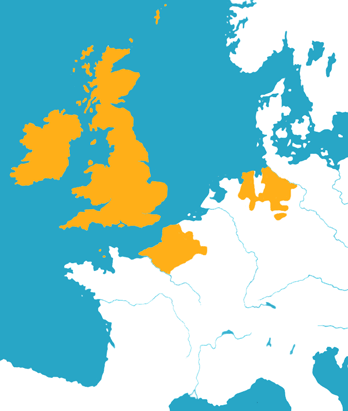
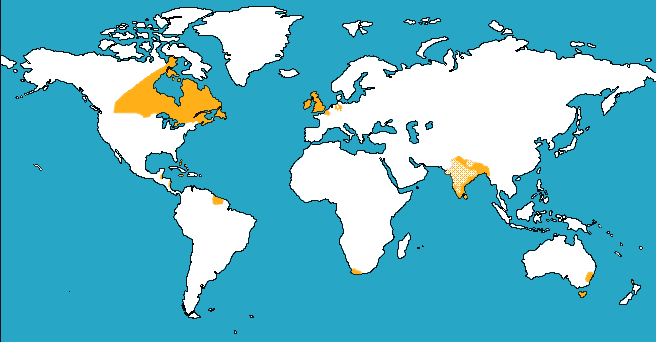
Britain's control of eastern North America lasted less than 20
years.
An administration insensitive to the rights and desires of the American
colonists led to the revolution of 1776. By 1781, a French fleet and a
Franco-American army was able to force the surrender of the main
British
force in North America, and the independence of the United States was
recognized
in 1783. Only Canada and Newfoundland remained British. The former
acquired
a majority English-speaking population from the influx of loyalists
from
the United States, and gradually pushed its territories westward.
Partly
to compensate for the loss of America, a penal colony was founded in
Australia
in 1788. By the end of the Napoleonic wars (1797-1815) Britain had
gained
South Africa and Ceylon from the Dutch, and Hanover had extended its
territory
in Germany. As one of the victorious allies, Britain also occupied part of France, north of Paris, from 1815 to 1818. In India, the East India Company steadily enlarged its
territories
and sphere of influence. 13,000 British troops failed, however, in an
invasion of the
Spanish territories in Argentina and Uruguay. Meanwhile, in 1801
Ireland had been invited to
join Great Britain to form a United Kingdom encompassing the whole of
the
British Isles (except for the Isle of Man which was, and still is,
administered
separately).
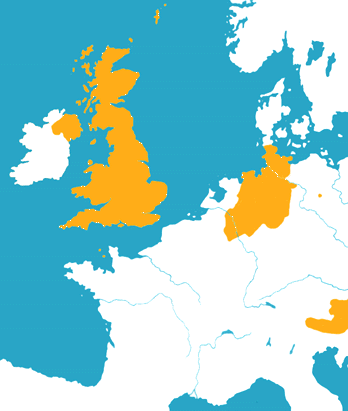
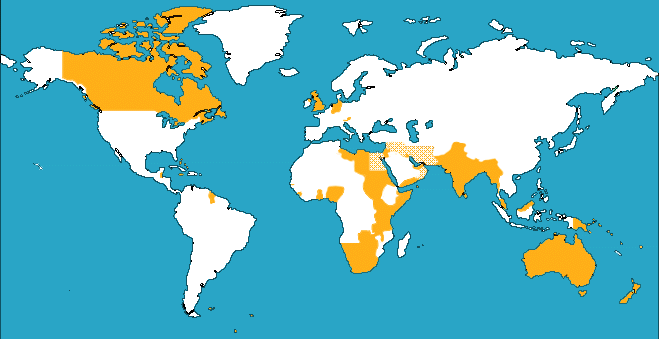
Hanover separated from Britain in 1820, but the royal family maintained its close ties with Germany. Queen Victoria married Prince Albert of Saxe-Coburg (which remains the ruling house of Britain although they renamed themselves Windsor in World War One). The British Empire expanded enormously during her reign (1837-1901), as a consequence of the industrial revolution which put Britain first in the world economically. Following the 1857 Indian Indian Mutiny, Britain took direct control of the whole sub-continent. The last Mogul Emperor was dethroned, and Victoria became Empress of India. Singapore was colonized in 1819, and Hong Kong in 1842. British expansion in South and East Asia was mostly over by 1886, by which time the focus of attention had moved to Africa. By 1912 the European carve-up of Africa was complete, and about a third of the continent's area and about half its population ended up under British rule. Egypt remained nominally part of the Ottoman Empire, but was under British control from 1882. Meanwhile Canada was extended to the Pacific coast in 1871, and all of Australia and New Zealand annexed by 1842 (although it would be generations before the interior of Australia was fully explored, let alone settled).
It is often said that the British Empire peaked in the 1920s,
following
World War One (1914-19), in which it gained most of the German
territories
in Africa, and Ottoman provinces in the Near East. This statement would
be true if the dominions (Canada, Newfoundland, South Africa, Australia
and New Zealand), were not counted part of the British Empire
after they were granted independence by the statute of Westminster in 1931.
However, it was not until 1947-9 that the
dominions established separate citizenships from the UK. And World War
Two (1939-45)
showed that the dominions (Ireland excluded) were indeed part of the
Empire: in 1939 the Australian
prime minister informed his country that Britain had declared war on
Germany and that "as a result Australia is also at war", and in 1940 millions
of pounds of gold were shipped to Canada in preparation for a possible
relocation
of the British royal family. By this reckoning, the Empire reached its
greatest extent following that war, in 1945. Most of the the Italian
territories
in Africa were occupied by Britain, as was all of North-West Germany
and parts of Austria and Berlin. Huge areas of the Middle East were
occupied (or reoccupied) during the war and beyond, to secure oil
supplies and seaways, or to remove regimes friendly to the Axis.
The map of the British Isles gives a truer picture of the power of the British Empire in 1945. After years of resentment of British domination, catholic Ireland gained independence as a dominion in 1921. The area around Belfast, with a Protestant majority, remained part of the renamed United Kingdom of Great Britain and Northern Ireland. Unlike the other dominions it took its independence seriously, establishing its own citizenship in 1935 and remaining neutral in World War Two. For this reason it is not included as part of the Empire in the above map. In 1949 Ireland became a republic and left the Commonwealth. Two years earlier India and Pakistan had also become republics, but remained within the Commonwealth, an example followed by most of the Empire. The rest of British Asia (apart from Hong Kong) had gained independence by 1971, when the UK abandoned any pretence of being a sea power outside the Atlantic and Mediterranean. British Africa had gained independence by 1968, and most British territories in the Americas by 1981. By that time, the only territories large enough to see on the scale of the above world maps were the Falkland Islands and South Georgia in the South Atlantic. Against the trend, Britain fought a short but deadly war in 1982 with Argentina to keep these sparsely inhabited islands.
The only remaining colony with a significant population (5 million), Hong Kong, was peacefully incorporated into China in 1997. Although Canada, New Zealand and Australia, plus a number of other nations, still have the British monarch as their head of state, they are no longer referred to as dominions, and have gradually abandoned almost all their formal political ties with Britain. This was hastened by Britain's turning its back on the Commonwealth and entering the European Economic Community in 1973. The end of Britain's 400-year old trans-oceanic Empire was made official in 1998, when all inhabitants of the few remaining overseas British territories became British citizens, with equal rights to those in the United Kingdom. At the same time, the Unity of that Kingdom is itself in question. Since 1999 Scotland has had its own parliament, for the first time in nearly 300 years, and Wales has had its own assembly, for the first time in nearly 600 years. With Ireland doing very well as a small country within the European Union, it may be that Scotland, and perhaps even Wales, will follow Ireland's example. If they do, then that will truly be the end of the British Empire, as England then will be a nation, not the core of an Empire.